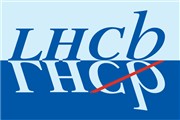In August 1995 a Letter of Intent was submitted for LHCb, the world’s first dedicated b-physics experiment at a hadron collider. Today, the LHCb Collaboration has marked the 20th anniversary of this event with a special celebratory meeting.
Click the cartoon (Adrien Miqueu author) for higher resolution.
The beauty quark b and anti-quark b bound-state Υ was discovered in 1977 at Fermilab. For many years after, the study of beauty hadrons, composed of a b quark or its anti-quark b and other quarks, was dominated by experiments at e+e– colliders, which included DORIS, CESR, VEPP and LEP. So called “fixed-target” experiments at hadron accelerators, at which beauty particles were produced in collisions of accelerated protons with stationary objects were limited in their scope, as the rate of beauty particle production was small compared to production rate of other particles. At hadron colliders, on the other hand, the beauty particle production rate is much higher. The Fermilab collider experiments CDF and D0 at the Tevatron, although not designed specifically for studies of beauty particles, took advantage of this opportunity and started to obtain interesting results in the 1990s. The e+e– collider B factory BaBar and Belle experiments were approved in 1993 and started to take data in 2000.
It was clear that the high proton-proton collision energy at the LHC would give rise to a very high beauty particle production rate. But how to conduct high precision experiments in this very difficult environment? At the LHC workshop in Evian in 1992 three b-physics experiments were proposed:
- COBEX proposed to use a forward spectrometer in the proton-proton colliding mode, as the majority of beauty particles are produced around the direction of colliding protons.
- LHB proposed to use extraction of protons from the collider in a fixed target experiment.
- GAJET proposed to inject a gas into a collider tube; the gas molecules could then play the role of a fixed target.
In June 1994 the LHC Committee decided not to approve any of the three individual experiments, but requested that the interested parties form one new collaboration to propose a single new experiment based on the collider mode to exploit its large bb cross section with a convincing trigger strategy. Adopting the collider mode was the correct choice since not enough b hadrons would have been produced at the LHC in a fixed target setup, compared with the B-factory and Tevatron experiments, which had performed beyond original expectations.
The Letter of Intent for LHCb was submitted in 1995 and the experiment was approved in 1998. The design of the experiment was re-optimized in 2003, a process in which many important improvements were made. The tracking stations in the magnet were removed, reducing strongly secondary interactions of particles from the beauty particle decays, instead all the first tracking stations were made in silicon technology. The particle interactions in the collider beam tube were reduced by replacing the standard technology with one made of beryllium. Finally, improvements in technology allowed the whole LHCb detector to be read out to the computer farm at a 1MHz rate, thereby improving the beauty particle selection process.
But what could be the name of the experiment and its logo? Alternative name versions were used 20 years ago: “LHC-B”, “LHCB” or “LHCb”. The final name was fixed in 1997 with the cute choice for the LHCb logo. Here the “cb” is transformed in the mirror image into “CP” which is then “violated” by the red bar pointing to “CP violation” as the one of the most important themes of LHCb research.
The ideas imagined 20 years ago have been very successful and allowed excellent physics results to be obtained, as reported on this web page. Beauty hadron distributions can be measured with background levels as low as those obtained at e+e– colliders and they are collected at much higher rate. In addition the production of all beauty mesons and baryons is observed at LHCb contrary to B-factory experiments, which are limited to studing light beauty meson decays only.
Read more about the history of LHCb, its physics results and prospects for future in the LHCb20-fest presentations. By clicking on the detector photos at the LHCb20-fest web page you can learn more about the LHCb detector. By clicking on the physics result images at the same web page you can learn more about significant LHCb results.


